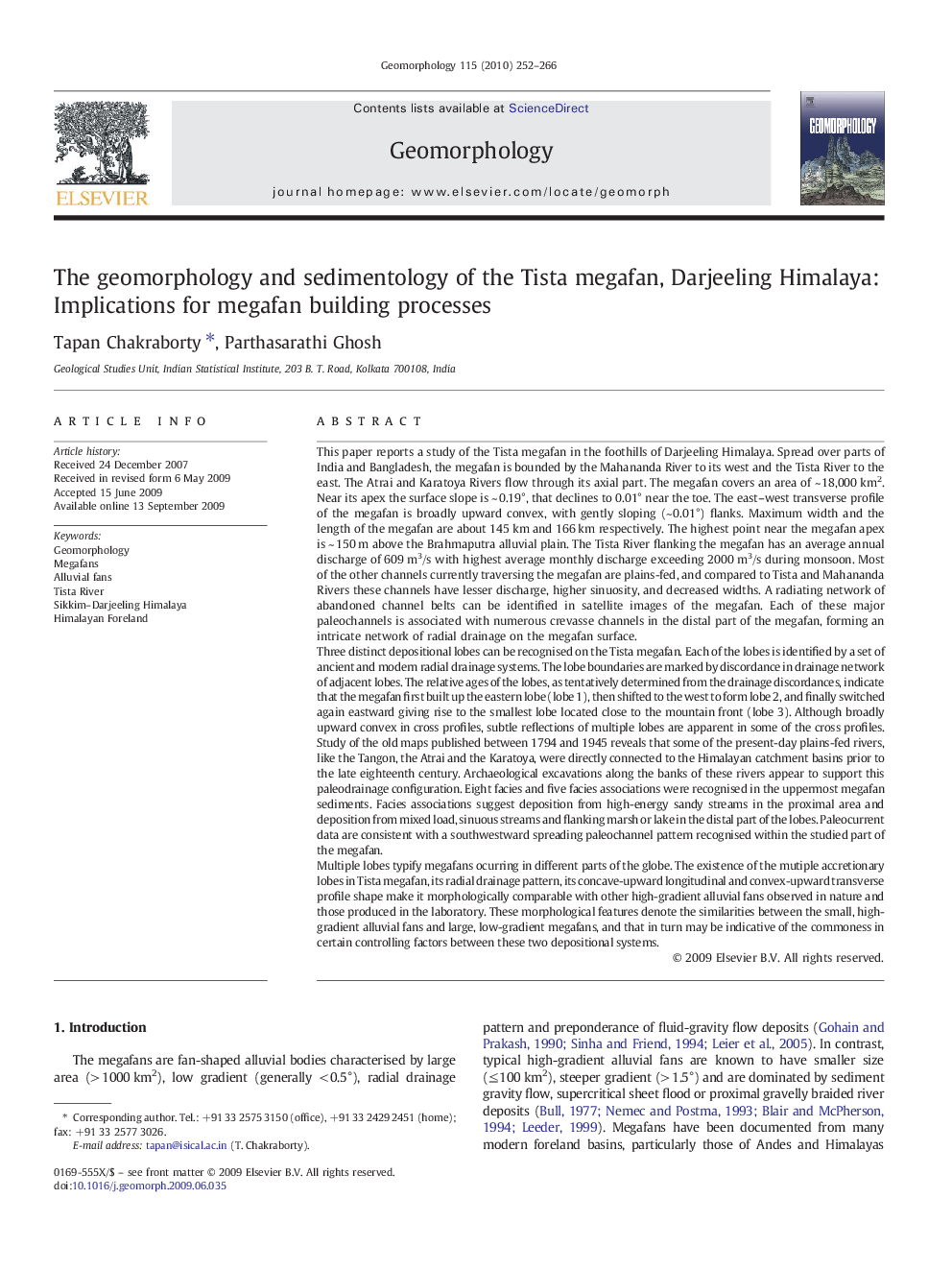| کد مقاله | کد نشریه | سال انتشار | مقاله انگلیسی | نسخه تمام متن |
|---|---|---|---|---|
| 4686151 | 1635528 | 2010 | 15 صفحه PDF | دانلود رایگان |

This paper reports a study of the Tista megafan in the foothills of Darjeeling Himalaya. Spread over parts of India and Bangladesh, the megafan is bounded by the Mahananda River to its west and the Tista River to the east. The Atrai and Karatoya Rivers flow through its axial part. The megafan covers an area of ~ 18,000 km2. Near its apex the surface slope is ~ 0.19°, that declines to 0.01° near the toe. The east–west transverse profile of the megafan is broadly upward convex, with gently sloping (~ 0.01°) flanks. Maximum width and the length of the megafan are about 145 km and 166 km respectively. The highest point near the megafan apex is ~ 150 m above the Brahmaputra alluvial plain. The Tista River flanking the megafan has an average annual discharge of 609 m3/s with highest average monthly discharge exceeding 2000 m3/s during monsoon. Most of the other channels currently traversing the megafan are plains-fed, and compared to Tista and Mahananda Rivers these channels have lesser discharge, higher sinuosity, and decreased widths. A radiating network of abandoned channel belts can be identified in satellite images of the megafan. Each of these major paleochannels is associated with numerous crevasse channels in the distal part of the megafan, forming an intricate network of radial drainage on the megafan surface.Three distinct depositional lobes can be recognised on the Tista megafan. Each of the lobes is identified by a set of ancient and modern radial drainage systems. The lobe boundaries are marked by discordance in drainage network of adjacent lobes. The relative ages of the lobes, as tentatively determined from the drainage discordances, indicate that the megafan first built up the eastern lobe (lobe 1), then shifted to the west to form lobe 2, and finally switched again eastward giving rise to the smallest lobe located close to the mountain front (lobe 3). Although broadly upward convex in cross profiles, subtle reflections of multiple lobes are apparent in some of the cross profiles. Study of the old maps published between 1794 and 1945 reveals that some of the present-day plains-fed rivers, like the Tangon, the Atrai and the Karatoya, were directly connected to the Himalayan catchment basins prior to the late eighteenth century. Archaeological excavations along the banks of these rivers appear to support this paleodrainage configuration. Eight facies and five facies associations were recognised in the uppermost megafan sediments. Facies associations suggest deposition from high-energy sandy streams in the proximal area and deposition from mixed load, sinuous streams and flanking marsh or lake in the distal part of the lobes. Paleocurrent data are consistent with a southwestward spreading paleochannel pattern recognised within the studied part of the megafan.Multiple lobes typify megafans ocurring in different parts of the globe. The existence of the mutiple accretionary lobes in Tista megafan, its radial drainage pattern, its concave-upward longitudinal and convex-upward transverse profile shape make it morphologically comparable with other high-gradient alluvial fans observed in nature and those produced in the laboratory. These morphological features denote the similarities between the small, high-gradient alluvial fans and large, low-gradient megafans, and that in turn may be indicative of the commoness in certain controlling factors between these two depositional systems.
Journal: Geomorphology - Volume 115, Issues 3–4, 1 March 2010, Pages 252–266